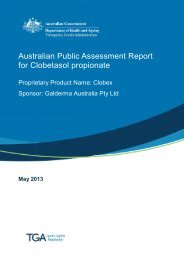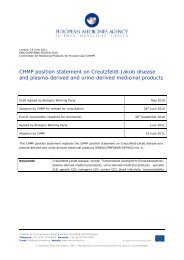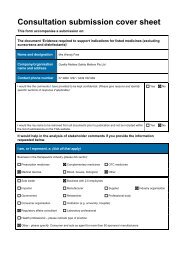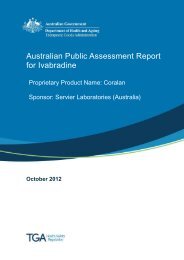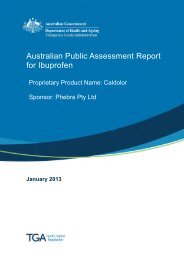AusPAR: Cabazitaxel - Therapeutic Goods Administration
AusPAR: Cabazitaxel - Therapeutic Goods Administration
AusPAR: Cabazitaxel - Therapeutic Goods Administration
You also want an ePaper? Increase the reach of your titles
YUMPU automatically turns print PDFs into web optimized ePapers that Google loves.
<strong>AusPAR</strong> Jevtana <strong>Cabazitaxel</strong> Sanofi-Aventis Australia Pty Ltd PM-2010-02565-3-4<br />
Final 9 February 2012<br />
<strong>Therapeutic</strong> <strong>Goods</strong> <strong>Administration</strong><br />
Table 7: Analysis populations - by study and treatment group (Phase III study EFC<br />
6193 and Phase I/Phase II studies)<br />
In study EFC 6193, a 25 mg/m 2 dose was chosen. In the two Phase I studies (TED 6188<br />
and TED 6190) and the Phase II study of patients with metastatic breast cancer (ARD<br />
6191), the dose ranged from 20 to 25 mg/m 2 every 3 weeks.<br />
The median duration of treatment ranged from 6.4 weeks to 18.6 weeks. In the pivotal<br />
study, the patients in the cabazitaxel arm received more cycles of study treatment (median<br />
6 cycles) compared with the mitoxantrone arm (median 4 cycles). Dose reductions of ><br />
20% were required in 9.8% of cycles in the cabazitaxel arm compared to 5.1% of cycles in<br />
the mitoxantrone arm. The median relative dose intensity (RDI) was 96.12% for the<br />
cabazitaxel arm and 97.25% for the mitoxantrone arm, suggesting that both arms were<br />
equally able to receive their respective intended doses. In the Phase I/II studies the<br />
median RDI for cabazitaxel 25 mg/m 2 was<br />
95%. In the combination treatment study (TCD 6945), the median RDIs were 95.5% and<br />
87.4% for cabazitaxel and capecitabine, respectively.<br />
Adverse events<br />
Treatment related adverse events (adverse drug reactions)<br />
Pivotal study<br />
In study EFC 6193, 95.7% of patients in the cabazitaxel arm and 88.4% of patients in the<br />
mitoxantrone arm reported a treatment emergent adverse effect (TEAE). Grade > 3 TEAEs<br />
were reported in 57.4% of the cabazitaxel arm and 39.4% of the mitoxantrone arm.<br />
Serious TEAEs were reported in 39.1% of the cabazitaxel arm and 20.8% of the<br />
mitoxantrone arm (Table 8).<br />
Table 8: Brief summary of adverse events - safety population<br />
The most common adverse events in both arms of the study were haematological adverse<br />
events, which included neutropenia and febrile neutropenia. They were more prominent<br />
Page 40 of 75





